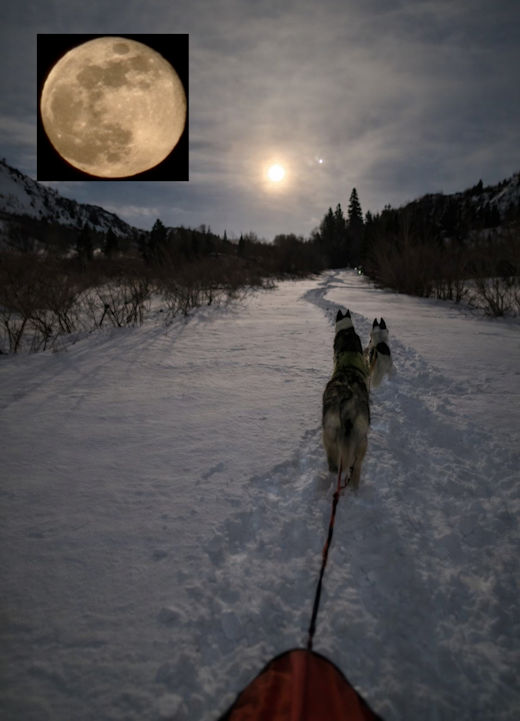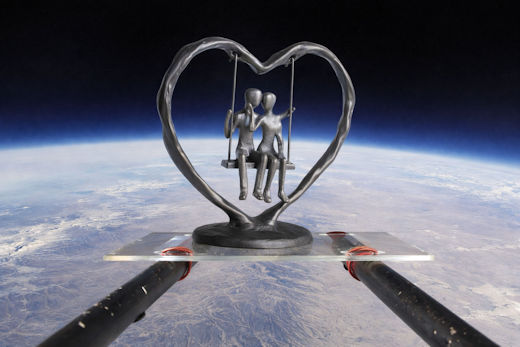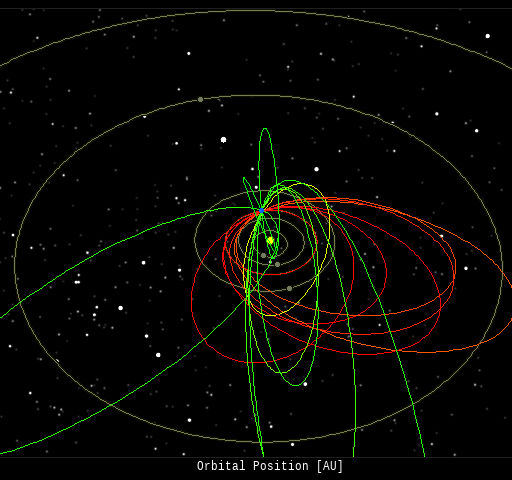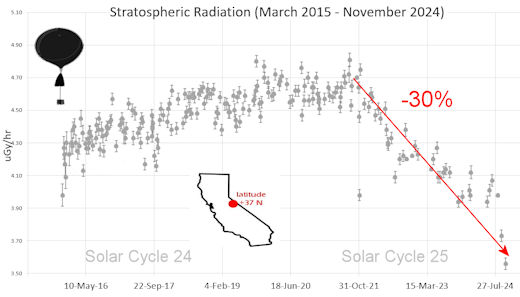 | | |  SPACE WEATHER
NOAA Forecasts | | Updated at: 2026 Jan 04 2200 UTC FLARE | 0-24 hr | 24-48 hr | CLASS M | 50 % | 50 % | CLASS X | 10 % | 10 % |  Geomagnetic Storms: Geomagnetic Storms:
Probabilities for significant disturbances in Earth's magnetic field are given for three activity levels: active, minor storm, severe storm Updated at: 2026 Jan 04 2200 UTC Mid-latitudes | 0-24 hr | 24-48 hr | ACTIVE | 25 % | 10 % | MINOR | 05 % | 01 % | SEVERE | 01 % | 01 % | High latitudes | 0-24 hr | 24-48 hr | ACTIVE | 15 % | 15 % | MINOR | 30 % | 15 % | SEVERE | 30 % | 10 % | | | |  | | | | | | | | | | | This is an AI Free Zone: Text created by Large Language Models is spreading across the Internet. It's well-written, but frequently inaccurate. If you find a mistake on Spaceweather.com, rest assured it was made by a real human being. | | | DOWNGRADED STORM FORECAST: A CME expected to hit Earth on Jan. 3rd missed. There's still a chance for an impact on Jan. 4th, though. A CME launched by a C6-class flare on Jan. 1st could arrive today and spark a minor G1-class geomagnetic storm. Aurora visibility will be poor due to the glare from this weekend's full Wolf Moon. CME impact alerts: SMS Text CHASING THE FULL WOLF MOON: Nothing energizes a sled dog like moonlight on fresh snow. Last night, these three chased the full Wolf Moon all the way to North Lake, CA, ~9300 feet above sea level: 
"The Moon flooded the landscape with bright moonlight," says Dr. Tony Phillips, a space weather forecaster who moonlights as a backcountry dogsledder. "It looked amazing in conjunction with Jupiter only a few degrees away." According to folklore, this weekend's full Moon is the Wolf Moon. It is brighter than normal for three reasons: 1. The Moon is near perigee (closest approach to Earth), making it appear up to ~7% larger and ~15% brighter than average. 2. The Earth-Moon system is near perihelion (closest approach to the sun), brightening the Moon another 3%. 3. Fresh snow reflects as much as 90% of incoming moonlight, effectively turning night into day. If you want to see a *really* bright Moon, go outside tonight and take a look. Jupiter is there, too. Dogs are not required (but recommended). [sky map] more images: from Ali Rahimi of Esfahan, Iran; from Jean-Christophe Vitu of Paris, France;
Realtime Space Weather Photo Gallery
Free: Spaceweather.com Newsletter IRON HEART VALENTINE'S GIFT: Valentine’s Day is coming. Do you have a truly far-out gift? The Iron Heart Valentine’s Swing celebrates a love that is strong, steady, and enduring. On Nov. 13, 2025, it flew to the edge of space, floating 100,895 feet above the Sierra Nevada Mountains of central California: 
You can have it for $159.95. The gift-boxed swing includes a unique keepsake card featuring the Iron Heart at the top of Earth's atmosphere. Inside, the card tells the story of the flight and certifies that this swing has been to the edge of space. Earth to Sky Valentine's gifts have flown above 99.7% of Earth's atmosphere, experiencing space-like blasts of cosmic rays, extreme cold, and a wild ride parachuting back to Earth after the balloon explodes. Even Amazon doesn't carry items this far out. And, best of all, all sales support student science projects and STEM education.
Far Out Gifts: Earth to Sky Store
All sales support hands-on STEM education
Realtime Comet Photo Gallery
Free: Spaceweather.com Newsletter
Realtime Aurora Photo Gallery
Free: Spaceweather.com Newsletter Every night, a network of NASA all-sky cameras scans the skies above the United States for meteoritic fireballs. Automated software maintained by NASA's Meteoroid Environment Office calculates their orbits, velocity, penetration depth in Earth's atmosphere and many other characteristics. Daily results are presented here on Spaceweather.com. On Jan. 03 2026, the network reported 15 fireballs.
(11 sporadics, 4 Quadrantids)  In this diagram of the inner solar system, all of the fireball orbits intersect at a single point--Earth. The orbits are color-coded by velocity, from slow (red) to fast (blue). [Larger image] [movies] Potentially Hazardous Asteroids ( PHAs) are space rocks larger than approximately 100m that can come closer to Earth than 0.05 AU. None of the known PHAs is on a collision course with our planet, although astronomers are finding new ones all the time. On January 4, 2026 there were 2349 potentially hazardous asteroids.
 | Recent & Upcoming Earth-asteroid encounters: | Asteroid | Date(UT) | Miss Distance | Velocity (km/s) | Diameter (m) | | 2025 YH6 | 2025-Dec-30 | 5.3 LD | 9 | 66 | | 2025 YZ4 | 2025-Dec-30 | 7.8 LD | 9.8 | 39 | | 2025 YQ5 | 2025-Dec-30 | 14.3 LD | 18.4 | 46 | | 2019 AU | 2025-Dec-30 | 19.3 LD | 2.8 | 16 | | 2025 YU5 | 2025-Dec-30 | 5.7 LD | 7.6 | 14 | | 2025 YG9 | 2025-Dec-30 | 2.2 LD | 8.3 | 8 | | 2024 AV2 | 2025-Dec-30 | 17.9 LD | 7 | 17 | | 2025 YL4 | 2026-Jan-01 | 3.8 LD | 9.8 | 16 | | 2025 XC7 | 2026-Jan-01 | 8.9 LD | 6.6 | 30 | | 2025 YZ | 2026-Jan-02 | 14.1 LD | 6.7 | 29 | | 2025 YS9 | 2026-Jan-02 | 7.7 LD | 11.2 | 20 | | 2025 YT2 | 2026-Jan-02 | 14.9 LD | 5.5 | 10 | | 2025 YV6 | 2026-Jan-03 | 4.4 LD | 5.7 | 12 | | 2025 YF3 | 2026-Jan-03 | 15.4 LD | 7 | 36 | | 2025 YF4 | 2026-Jan-03 | 12.6 LD | 7.3 | 22 | | 2025 YN7 | 2026-Jan-04 | 6.6 LD | 8.2 | 19 | | 2025 YA4 | 2026-Jan-04 | 13.1 LD | 15.6 | 40 | | 2025 YQ7 | 2026-Jan-04 | 4.8 LD | 7.8 | 19 | | 2025 YV7 | 2026-Jan-04 | 4.4 LD | 13.6 | 16 | | 2014 AF16 | 2026-Jan-04 | 8 LD | 9.5 | 34 | | 2025 YY3 | 2026-Jan-05 | 18 LD | 13.2 | 32 | | 2025 YM6 | 2026-Jan-05 | 12.4 LD | 7.5 | 19 | | 2025 YV1 | 2026-Jan-05 | 11.8 LD | 16.4 | 63 | | 2025 XS4 | 2026-Jan-06 | 8 LD | 6.5 | 25 | | 2025 YW7 | 2026-Jan-06 | 11.9 LD | 17.1 | 64 | | 2023 XM15 | 2026-Jan-07 | 15.2 LD | 6.9 | 51 | | 2025 YY8 | 2026-Jan-08 | 12.4 LD | 6.6 | 37 | | 2025 YU6 | 2026-Jan-11 | 4.1 LD | 4.7 | 23 | | 2025 YL | 2026-Jan-11 | 7.4 LD | 3.9 | 13 | | 2025 YR7 | 2026-Jan-12 | 9.3 LD | 8.9 | 24 | | 2022 GR3 | 2026-Jan-12 | 14.5 LD | 12.9 | 9 | | 2025 XN1 | 2026-Jan-14 | 9.3 LD | 4.7 | 36 | | 2022 OB5 | 2026-Jan-14 | 1.7 LD | 2.2 | 6 | | 2025 BL | 2026-Jan-17 | 4.7 LD | 6.9 | 28 | | 2004 MO3 | 2026-Jan-17 | 17 LD | 10.2 | 129 | | 2011 AM37 | 2026-Jan-17 | 19.8 LD | 5.1 | 4 | | 2025 YX7 | 2026-Jan-20 | 19.5 LD | 11.5 | 78 | | 2019 LZ4 | 2026-Jan-23 | 14.2 LD | 11.6 | 45 | | 2025 YR1 | 2026-Jan-27 | 19.5 LD | 4.1 | 30 | | 2022 AG | 2026-Jan-29 | 13.7 LD | 5.3 | 34 | | 2020 GE | 2026-Jan-29 | 16.2 LD | 1.2 | 8 | | 2023 RX1 | 2026-Jan-31 | 8.8 LD | 1.2 | 3 | | 2022 OC3 | 2026-Jan-31 | 1.3 LD | 3.8 | 8 | | 2021 CZ5 | 2026-Feb-09 | 18.3 LD | 9.3 | 23 | | 2025 CC | 2026-Feb-09 | 17.6 LD | 5.1 | 11 | | 2019 CN2 | 2026-Feb-11 | 20 LD | 9.2 | 7 | | 2022 DV | 2026-Feb-12 | 15.4 LD | 5 | 18 | | 1999 AO10 | 2026-Feb-13 | 10.5 LD | 2.7 | 59 | | 162882 | 2026-Feb-14 | 17 LD | 19.2 | 626 | | 2023 CM2 | 2026-Feb-21 | 4.2 LD | 11.4 | 22 | | 2025 DQ | 2026-Feb-21 | 3 LD | 6.8 | 4 | | 2007 DB61 | 2026-Feb-21 | 9 LD | 8.8 | 65 | | 2012 XF55 | 2026-Feb-23 | 16.3 LD | 4 | 98 | | 2022 EZ6 | 2026-Feb-24 | 11.6 LD | 6.9 | 73 | | 2018 RB1 | 2026-Feb-24 | 8.3 LD | 7.9 | 9 | | 2011 CL50 | 2026-Feb-27 | 13.4 LD | 4.5 | 12 | | 2020 FV4 | 2026-Feb-27 | 16.3 LD | 8.7 | 30 | | 2007 DG8 | 2026-Feb-28 | 10 LD | 9.9 | 32 | | 2011 EH17 | 2026-Mar-02 | 15.8 LD | 16.5 | 39 | Notes: LD means "Lunar Distance." 1 LD = 384,401 km, the distance between Earth and the Moon. 1 LD also equals 0.00256 AU. | | Cosmic Rays in the Atmosphere | SPACE WEATHER BALLOON DATA: Almost once a week, Spaceweather.com and the students of Earth to Sky Calculus fly space weather balloons to the stratosphere over California. These balloons are equipped with sensors that detect secondary cosmic rays, a form of radiation from space that can penetrate all the way down to Earth's surface. Our monitoring program has been underway without interruption for 10 years, resulting in a unique dataset of in situ atmospheric measurements. Latest results (Nov. 2024): Atmospheric radiation is sharply decreasing in 2024. Our latest measurements in November registered a 10-year low: 
What's going on? Ironically, the radiation drop is caused by increasing solar activity. Solar Cycle 25 has roared to life faster than forecasters expected. The sun's strengthening and increasingly tangled magnetic field repels cosmic rays from deep space. In addition, solar coronal mass ejections (CMEs) sweep aside cosmic rays, causing sharp reductions called "Forbush Decreases." The two effects blend together to bring daily radiation levels down. .Who cares? Cosmic rays are a surprisingly "down to Earth" form of space weather. They can alter the chemistry of the atmosphere, trigger lightning, and penetrate commercial airplanes. According to a study from the Harvard T.H. Chan school of public health, crews of aircraft have higher rates of cancer than the general population. The researchers listed cosmic rays, irregular sleep habits, and chemical contaminants as leading risk factors. A number of controversial studies (#1, #2, #3, #4) go even further, linking cosmic rays with cardiac arrhythmias and sudden cardiac death. Technical notes: The radiation sensors onboard our helium balloons detect X-rays and gamma-rays in the energy range 10 keV to 20 MeV. These energies span the range of medical X-ray machines and airport security scanners. Data points in the graph labeled "Stratospheric Radiation" correspond to the peak of the Regener-Pfotzer maximum, which lies about 67,000 feet above central California. When cosmic rays crash into Earth's atmosphere, they produce a spray of secondary particles that is most intense at the entrance to the stratosphere. Physicists Eric Regener and Georg Pfotzer discovered the maximum using balloons in the 1930s and it is what we are measuring today. | | The official U.S. government space weather bureau | | | The first place to look for information about sundogs, pillars, rainbows and related phenomena. | | | Researchers call it a "Hubble for the sun." SDO is the most advanced solar observatory ever. | | | 3D views of the sun from NASA's Solar and Terrestrial Relations Observatory | | | Realtime and archival images of the Sun from SOHO. | | | information about sunspots based on the latest NOAA/USAF Active Region Summary | | | current counts of failed and deployed Starlink satellites from Jonathan's Space Page. See also, all satellite statistics. | | | Authoritative predictions of space junk and satellite re-entries | | | from the NOAA Space Environment Center | | | fun to read, but should be taken with a grain of salt! Forecasts looking ahead more than a few days are often wrong. | | | from the NOAA Space Environment Center | | | the underlying science of space weather |  | Got a chipped or cracked windshield that prevents you from seeing space weather events while driving? Get windshield replacement from SR Windows & Glass with free mobile auto glass service anywhere in the Phoenix area. | | | These links help Spaceweather.com stay online. Thank you to our supporters! |  | | Baltimore Car Accident Lawyers Onlinecasinoinformatie.com is an expert in comparing foreign online casinos for players in the Netherlands, offering reliable insights, clear reviews, and up-to-date information Trusted casinos not connected to GamStop Most Trusted seller for 1:1 super clone watches in the market Premium quality super clone watches for sale with true 1:1 detailing Buy Instagram Followers Text: from Smikky! For the new best Norwegian casinos, visit nyecasino.com
Instant Famous, a reliable provider for followers, likes, and views on Instagram, Facebook, YouTube, TikTok, and more.
NonGamstopCasinos.net compares Non Gamstop Casinos and UK Casinos & Betting sites not on Gamstop. Independent casino reviews & exclusive bonus offers for British Gamblers. Zamsino is one of the most popular online casino guides in the world. Kiwislots.nz is the best free spins no deposit guide in New Zealand! Find your best no deposit bonus in Germany at BetterBonus Adlerslots hat die besten neuen Boni ohne Einzahlung in Deutschland für dich zusammengestellt! BonusZonderStorting.com is de nummer 1 site om online casino's zonder storting in Nederland te vergelijken. Vind de nieuwste free spins-aanbiedingen ter wereld op Leeuwslots.com. Visit prestigewatches for best super clone watches and rolex replica for sale
| | | | | | |  | |  |   | ©2021 Spaceweather.com. All rights reserved. This site is penned daily by Dr. Tony Phillips. |

